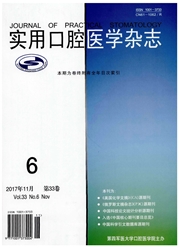

 中文摘要:
中文摘要:
目的:评价早期功能训练指导预防膝关节周围骨折术后膝关节僵硬的效果。方法选择2012年1-12月在我院行手术治疗的膝关节周围骨折患者132例,随机分为实验组和对照组各66例。对照组患者实施术后常规护理,实验组患者术后早期即采用持续膝关节被动运动(CPM)机进行辅助性功能锻炼。结果术后康复早期实验组和对照组膝关节ROM均有明显的增加(P〈0.05),但实验组在术后2周至8周膝关节ROM均明显大于对照组(P〈0.05)。实验组和对照组术后康复中长期膝关节功能恢复LKSS评分均明显提高(P〈0.05),实验组在3个月、6个月、12个月的LKSS评分均显著高于对照组(P〈0.05)。实验组和对照组术后康复中长期站立平衡性BBS评分均明显提高(P〈0.05),实验组在3个月、6个月、12个月的BBS评分均显著高于对照组(P〈0.05)。结论膝关节周围骨折术后制动易发生膝关节僵硬影响康复效果,术后早期实施膝关节辅助性训练指导,有助于患者接受早期康复训练,并促进膝关节功能恢复,预防膝关节僵硬发生。
 英文摘要:
英文摘要:
Objective To evaluate the effect of early functional training guidance prevention of knee stiffness after frac-tures around the knee. Methods Choose From January 2012 to December 2012 in our hospital around knee fracture surgery 132 patients, were randomly divided into experimental group and the control group , 66 cases in the control group after the implementation of routine care, patients in the experimental group after the early stage used continuous passive motion of the knee ( CPM ) machine auxiliary functional exercise . Results Early postoperative rehabilitation experimental group and the control group were significantly increased knee ROM (P〈0.05), but the experimental group after 2-8 weeks of knee ROM were significantly greater than in the control group (P〈0.05). Postoperative rehabilitation and long-term experimental and control groups LKSS knee function scores were significantly improved recovery (P〈0.05), the experimental group in three months, six months, 12 months LKSS scores were significantly higher (P〈0.05). Postop-erative recovery and long-term experimental group and the control group standing balance BBS scores were significantly increased (P〈0.05), the experimental group at 3 months, 6 months, 12 months of BBS scores were significantly higher (P〈0.05). Conclusion Fractures around the knee after knee stiffness brake prone to affect rehabilitation , assistive knee surgery early implementation coaching helps patients receive early rehabilitation promote functional recovery of the knee and prevented to occur knee stiffness.
 同期刊论文项目
同期刊论文项目
 同项目期刊论文
同项目期刊论文
 Effect of calcitonin gene-related peptide on osteoblast differentiation in an osteoblast and endothe
Effect of calcitonin gene-related peptide on osteoblast differentiation in an osteoblast and endothe Effect of calcitonin gene-related peptide on nitric oxide production in osteoblasts: an experimental
Effect of calcitonin gene-related peptide on nitric oxide production in osteoblasts: an experimental 期刊信息
期刊信息
